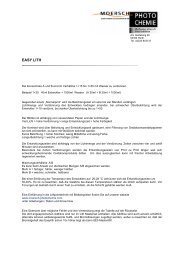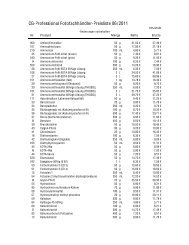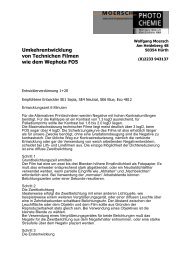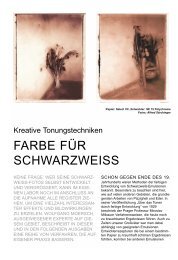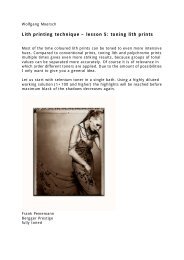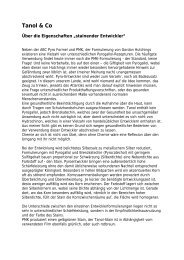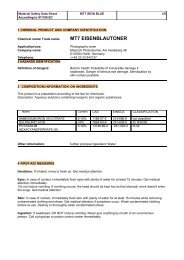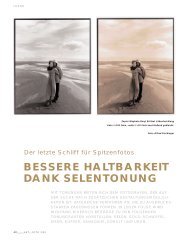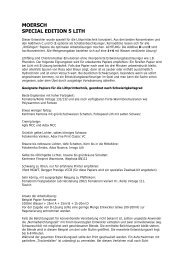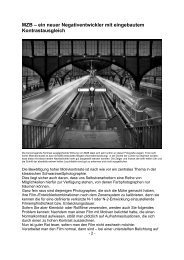toning lith prints - Moersch Photochemie
toning lith prints - Moersch Photochemie
toning lith prints - Moersch Photochemie
Create successful ePaper yourself
Turn your PDF publications into a flip-book with our unique Google optimized e-Paper software.
Wolfgang <strong>Moersch</strong><br />
Lith printing technique – lesson 5: <strong>toning</strong> <strong>lith</strong> <strong>prints</strong><br />
Most of the time coloured <strong>lith</strong> <strong>prints</strong> can be toned to even more intensive<br />
hues. Compared to conventional <strong>prints</strong>, <strong>toning</strong> <strong>lith</strong> and polychrome <strong>prints</strong><br />
multiple times gives even more striking results, because groups of tonal<br />
values can be separated more accurately. Of course it is of relevance in<br />
which order different toners are applied. Due to the amount of possibilities<br />
I only want to give you a general idea.<br />
Let us start with selenium toner in a single bath. Using a highly diluted<br />
working solution (1+100 and higher) the highlights will be reached before<br />
maximum black of the shadows decreases again.<br />
Frank Peinemann<br />
Bergger Prestige<br />
fully toned
If you only want to intensify the deepest blacks or decrease their greenish<br />
cast, you have to tone in a strong toner solution (1+5 to 1+20) for<br />
between 15 and 60 seconds.<br />
Gerd Münz<br />
Fomabrom<br />
toned in selenium (1+15) for 60 seconds<br />
I did not want to change the highlight tone. The objective was to intensify<br />
the shadows.
Wolfgang <strong>Moersch</strong><br />
Select Sepia VC<br />
This print was only toned for 20 seconds in a solution of 1+5, which<br />
shifted the greenish black shadow tone to magenta. The mid tones<br />
received a whiff of blue while the highlights remained unchanged.
Rolf H. Funke<br />
Fomatone<br />
Toning briefly in selenium quickly shifts the greenish shadow tone towards<br />
magenta. The blacks increase considerably.
Christian Schicker<br />
Select Sepia<br />
Polychrome print heavily toned in selenium<br />
Prints produced with the polychrome technique (two bath development <strong>lith</strong><br />
+ ammonia alkaline glycine developer) virtually tear the selenium out of<br />
the toner. All hues between red and blue are possible. Crucial here is the<br />
time of <strong>toning</strong>.
Frank Peinemann<br />
Fortezo Museum<br />
toned in selenium and sulphur<br />
Pure sulphur <strong>toning</strong> usually brings back the highlight tone just as it was<br />
prior to bleaching. A different result can be accomplished by combining<br />
selenium and sulphur.
Frank Stölben<br />
Select Shedlight<br />
toned heavily in selenium and briefly in copper<br />
I could have skipped the second toner, but a whiff of copper seemed just<br />
right for this picture.
Matthias Stalter<br />
Agfa MCC<br />
bleached and then toned in carbon toner<br />
A stronger result than in selenium can be obtained in my carbon toner.<br />
For this reason you should normally use it highly diluted. Here, the<br />
highlights were slightly bleached and then toned in a 1+20 solution for 30<br />
seconds.
Wolfgang <strong>Moersch</strong><br />
Select Sepia VC<br />
The same <strong>toning</strong> method leads to quite a different result on Select Sepia:<br />
two bath development<br />
1. <strong>lith</strong> 1+8 60A + 40B + 10D + 800water<br />
2. VGT 10A + 2B + 20C + 1000water<br />
highlights slightly bleached and toned in carbon toner<br />
The effect of carbon toner can easily be seen if you compare a toned print<br />
with its untoned version.
A.S.C.<br />
Select Sepia VC<br />
left: pure <strong>lith</strong><br />
right: toned in carbon toner (1+10) for 1 minute
A.S.C.<br />
Fomatone<br />
left: pure <strong>lith</strong><br />
right: toned in carbon 1+40 for 30 seconds
Wolfgang <strong>Moersch</strong><br />
Kentmere Kentona<br />
toned in selenium for the shadows and in gold for the highlights<br />
A <strong>lith</strong> print on Kentona reacts superbly to all sorts of <strong>toning</strong>. The reaction<br />
is quick and drastic. If you want to slow down the process to be able to<br />
assess the result, you have to use a highly diluted working solution. Here<br />
an example for split <strong>toning</strong> in selenium and gold. First, I fully toned the<br />
shadows in selenium. After thoroughly rinsing the print I toned the<br />
highlights blue in gold toner.<br />
For more Information visit www.moersch-photochemie.com



